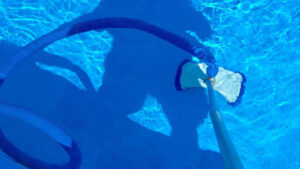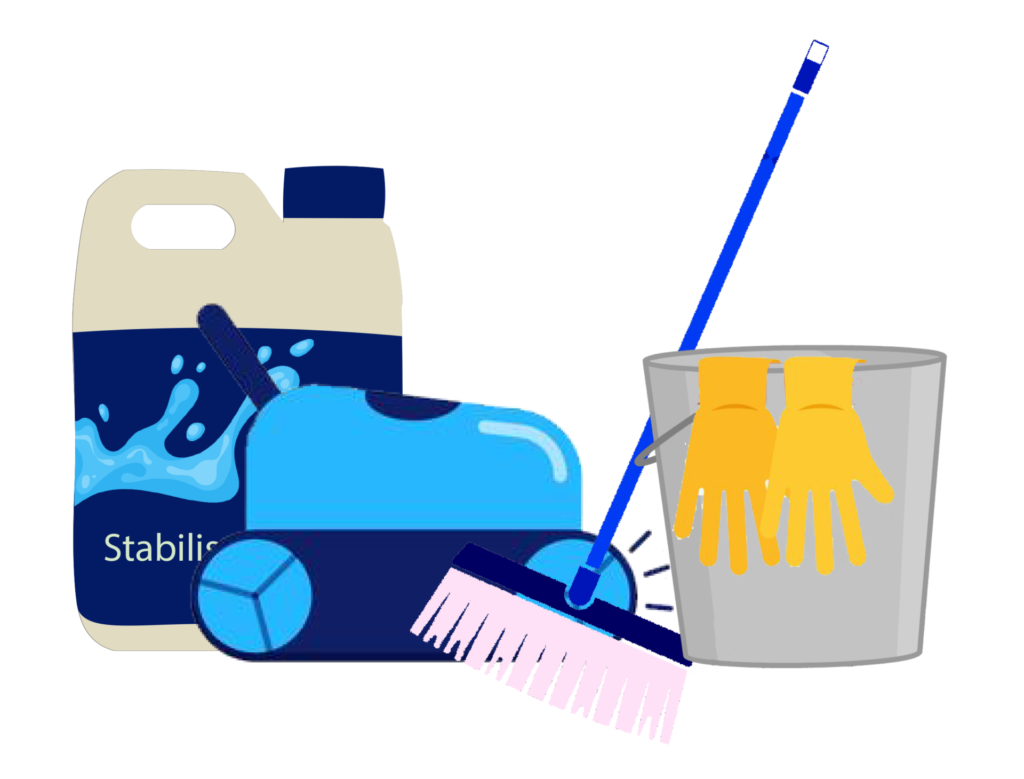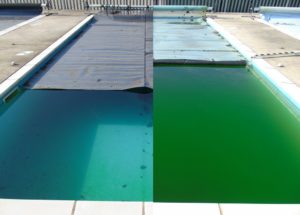11 steps for a summer-ready pool
How to open up your pool after the winter
1. Remove cover
- Wind up the pool cover carefully ensuring as few leaves and debris enter the pool as possible.
2. Clean the cover
- Place the cover flat side up with the bubbles facing down.
- If possible use the space available around the pool by setting the reel system back, creating a flat surface between the reel and pool.
- Your cover can also be laid out on a lawn to be cleaned, but please take note of our ‘Top tips’ below.
- Rinse down with a hose or jet washer (ensure jet washer kept 20cm – 30cm from cover).
- Use a soft brush to remove embedded residue.
3.Clear the pool of debris
- Use deep net or skimmer net to clear leaves and debris from surface and floor of the pool.
- Open and empty skimmer baskets, clean inside of skimmer.
4. Deep clean the pool

- Use a soft pool brush to brush away algae and dirt off walls and floor of the pool.
- Remove inlet cover plates and eyeball inlet nozzles and clean.
- Vacuum the pool – Run your robotic cleaner to remove the last residue at the bottom of the pool.
5. Top up water levels
- Run hose line to the pool and bring the water level to the middle of the skimmer.
You will need:
- Goggles
- Comfort mask
- Rubber gloves
- Soft pool brush
- Pool vacuum and hose or robotic cleaner
- Buckets
- Pool chemical testing kit
- Jet washer (for cover)
Chemicals required:
- Shock Chlorine
- Stabilized Chlorine
- pH plus
- pH minus
- Calcium hardness
- Alkalinity increaser
- Algaecide

6. Set up the filter
- Ensure pump is switched off and turn off inlets, main drain, and skimmer valves to pump and filter.
- Open the lid to the pump remove the pump filter basket.
- Clean the pump filter basket and reinstall.
- Ensure the pump seal is clean and reinstall.
- Use a bucket of water to help prime pump. Replace pump lid.
- Open inlets, main drain, and skimmer valves to pump and filter.
- Switch on pump for 24 hours, ensuring the multi-port valve is set to “filtration”
- Backwash the pool filtration as required
7. Check chemical levels and balance pool
- Take water samples from the pool (ensure taken 20cm under the water level).
- Check pH, Free Chlorine (FC), Combined Chlorine (CC), (calculate Total Chlorine (TC)), Calcium Hardness (CH) and Total Alkalinity (TA).
- Take appropriate actions to balance pH, CH and TA (take time to allow chemicals to settle).
- Add stabilised chlorine to level the pool between 2-4ppm.
- Allow to settle and recheck chemical levels
8. Shock the pool (if required)
- Put on PPE and weigh out shock chlorine.
- Fill bucket with warm water.
- Add the required shock to the bucket slowly.
- Stir until dissolved.
- Add shock slowly to the pool moving around the pool and ensuring not to splash and to pay attention around the skimmer.
- Ensure all pool equipment is cleaned thoroughly.
- Leave and allow the shock to do its work.
- Repeat as needed.
- Ensure the pool cover is off the pool water until the free chlorine level has returned to 2 – 4 ppm
9. Reinstall the cover
- When the chemical levels have returned to industry standards, reattach cover to reel and install on pool.
10. Set the pump and filtration timings
- Check the inlet nozzles are set to provide the best possible circulation.
- Set the filtration time schedule ensuring enough time to completely circulate the pool.
- For best heating performance set filtration to turn during the sunlight hours between 11 and 4.
Top tips from R&D:
- Always add your chemicals to a bucket of water first – never put directly into pool
- Make sure that you have separate buckets for the mixing of different chemicals
- Remember to rinse your cleaning equipment after use to prevent the reintroduction of algae.
- A flocculant can be used to help clear the dead algae dropping it to the pool floor where it can be cleared.
- Remember that an imbalanced pool can generate false chemical readings. Use distilled water to dilute the test sample to double check any strange readings.
- Take care not to leave your cover on your lawn for for too long, as the cover’s solar heating properties may lead to scorched grass.
11. Check, check and Recheck
- Recheck pH, FC, CC ,TC and make adjustments if required.
Nothing is ore valuable than time!
Selecting the right cover can drastically reduce the maintenance time needed to bring your pool back to usable condition.
The photograph on the right shows a pool left during the winter period with a (transparent) transmission cover and one with EnergyGuard™ Selective Transmission.
EnergyGuard™ Selective Transmission’s patented properties create a cover for summer and winter, keeping your pool clean, reducing chemical costs and saving time – giving you more time to enjoy your pool!















